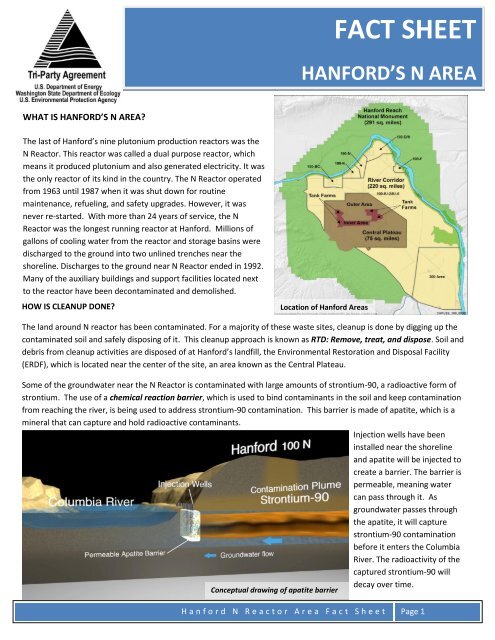Hanford's N Area Fact Sheet - Hanford Site
Hanford's N Area Fact Sheet - Hanford Site
Hanford's N Area Fact Sheet - Hanford Site
Create successful ePaper yourself
Turn your PDF publications into a flip-book with our unique Google optimized e-Paper software.
FACT SHEET<br />
HANFORD’S N AREA<br />
WHAT IS HANFORD’S N AREA?<br />
The last of <strong>Hanford</strong>’s nine plutonium production reactors was the<br />
N Reactor. This reactor was called a dual purpose reactor, which<br />
means it produced plutonium and also generated electricity. It was<br />
the only reactor of its kind in the country. The N Reactor operated<br />
from 1963 until 1987 when it was shut down for routine<br />
maintenance, refueling, and safety upgrades. However, it was<br />
never re-started. With more than 24 years of service, the N<br />
Reactor was the longest running reactor at <strong>Hanford</strong>. Millions of<br />
gallons of cooling water from the reactor and storage basins were<br />
discharged to the ground into two unlined trenches near the<br />
shoreline. Discharges to the ground near N Reactor ended in 1992.<br />
Many of the auxiliary buildings and support facilities located next<br />
to the reactor have been decontaminated and demolished.<br />
HOW IS CLEANUP DONE?<br />
Location of <strong>Hanford</strong> <strong>Area</strong>s<br />
Location of <strong>Hanford</strong>’s N <strong>Area</strong><br />
The land around N reactor has been contaminated. For a majority of these waste sites, cleanup is done by digging up the<br />
contaminated soil and safely disposing of it. This cleanup approach is known as RTD: Remove, treat, and dispose. Soil and<br />
debris from cleanup activities are disposed of at <strong>Hanford</strong>’s landfill, the Environmental Restoration and Disposal Facility<br />
(ERDF), which is located near the center of the site, an area known as the Central Plateau.<br />
Some of the groundwater near the N Reactor is contaminated with large amounts of strontium-90, a radioactive form of<br />
strontium. The use of a chemical reaction barrier, which is used to bind contaminants in the soil and keep contamination<br />
from reaching the river, is being used to address strontium-90 contamination. This barrier is made of apatite, which is a<br />
mineral that can capture and hold radioactive contaminants.<br />
Injection wells have been<br />
installed near the shoreline<br />
and apatite will be injected to<br />
create a barrier. The barrier is<br />
permeable, meaning water<br />
can pass through it. As<br />
groundwater passes through<br />
the apatite, it will capture<br />
strontium-90 contamination<br />
before it enters the Columbia<br />
River. The radioactivity of the<br />
captured strontium-90 will<br />
decay over time.<br />
Conceptual drawing of apatite barrier<br />
H a n f o r d N R e a c t o r A r e a F a c t S h e e t Page 1
HOW MUCH CLEANUP HAS BEEN<br />
COMPLETED?<br />
The images on the left show the major<br />
changes to the N <strong>Area</strong> landscape. Numerous<br />
buildings have been demolished and<br />
contaminated soil removed. As of 2012,<br />
cleanup in the N <strong>Area</strong> includes:<br />
<br />
<br />
<br />
Demolishing 92 buildings<br />
Cleaning up 22 waste sites<br />
Installation of test injections for<br />
apatite barrier formation<br />
HOW MUCH MORE NEEDS TO BE<br />
DONE?<br />
Continued cleanup of contaminated<br />
soil and groundwater is still needed in<br />
the N <strong>Area</strong>. The next major step will be<br />
developing and issuing a final cleanup<br />
decision for this reactor area. This<br />
cleanup action will be determined in a<br />
final cleanup decision on which you can<br />
provide input!<br />
HOW TO GET INVOLVED AND STAY INFORMED<br />
The public can provide input on what cleanup decisions the Tri-Party Agreement agencies select. Before a cleanup<br />
plan is selected, a document called a Proposed Plan, is issued for public review and comment. Your input on the<br />
Proposed Plan is factored in to the decision-making process. If you want to be aware of upcoming Proposed Plans<br />
and other <strong>Hanford</strong> decisions, join the electronic mailing list. You will receive information on upcoming public<br />
involvement opportunities and updates on <strong>Hanford</strong> activities. Join the <strong>Hanford</strong> email list at http://listserv.wa.gov.<br />
Information on upcoming events is also available on the following online calendars:<br />
<strong>Hanford</strong> Events Calendar: www.hanford.gov/pageaction.cfm/calendar<br />
TPA Public Involvement Calendar: www.ecy.wa.gov/programs/nwp/public.htm<br />
H a n f o r d N R e a c t o r A r e a F a c t S h e e t Page 2
















